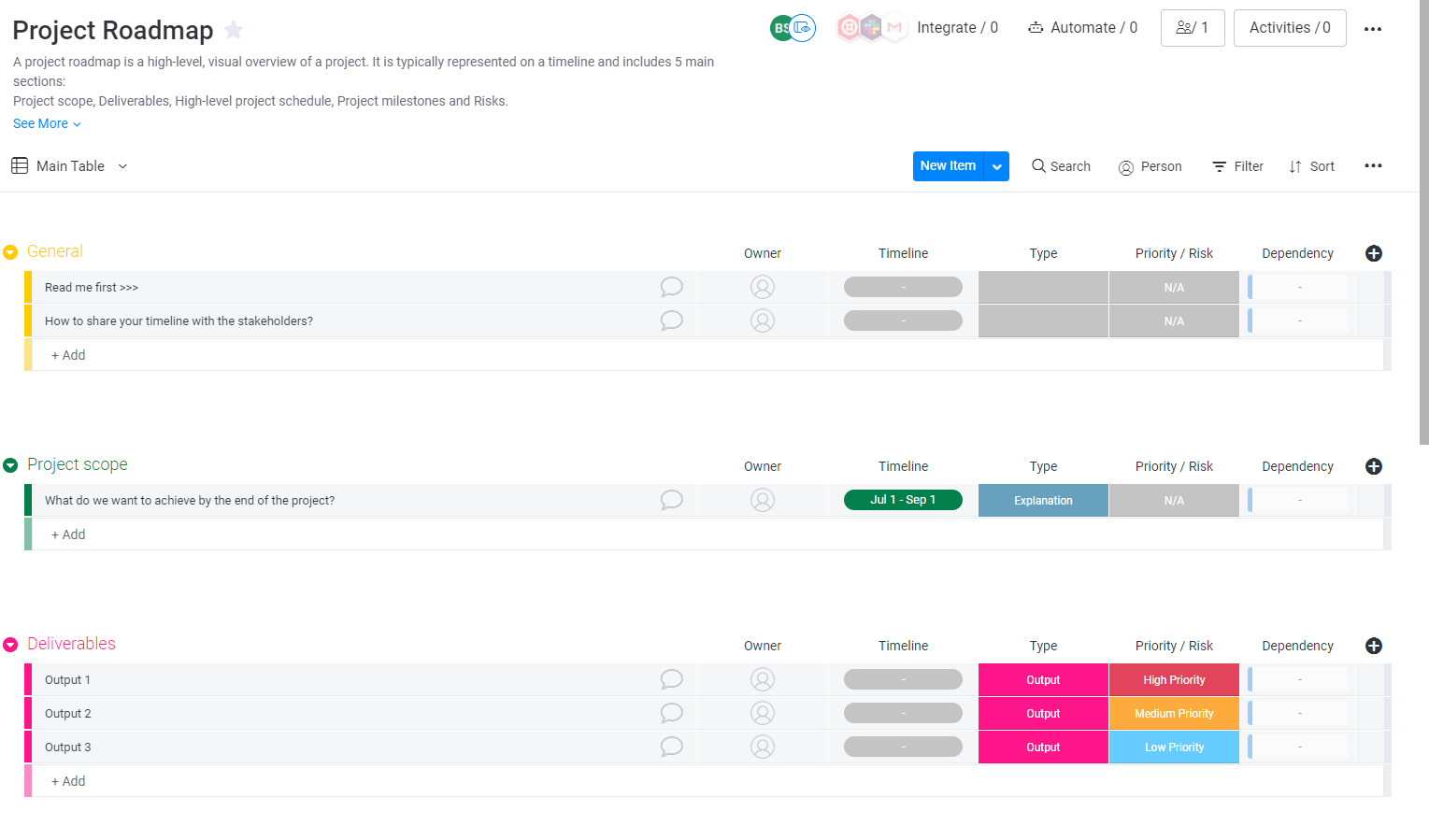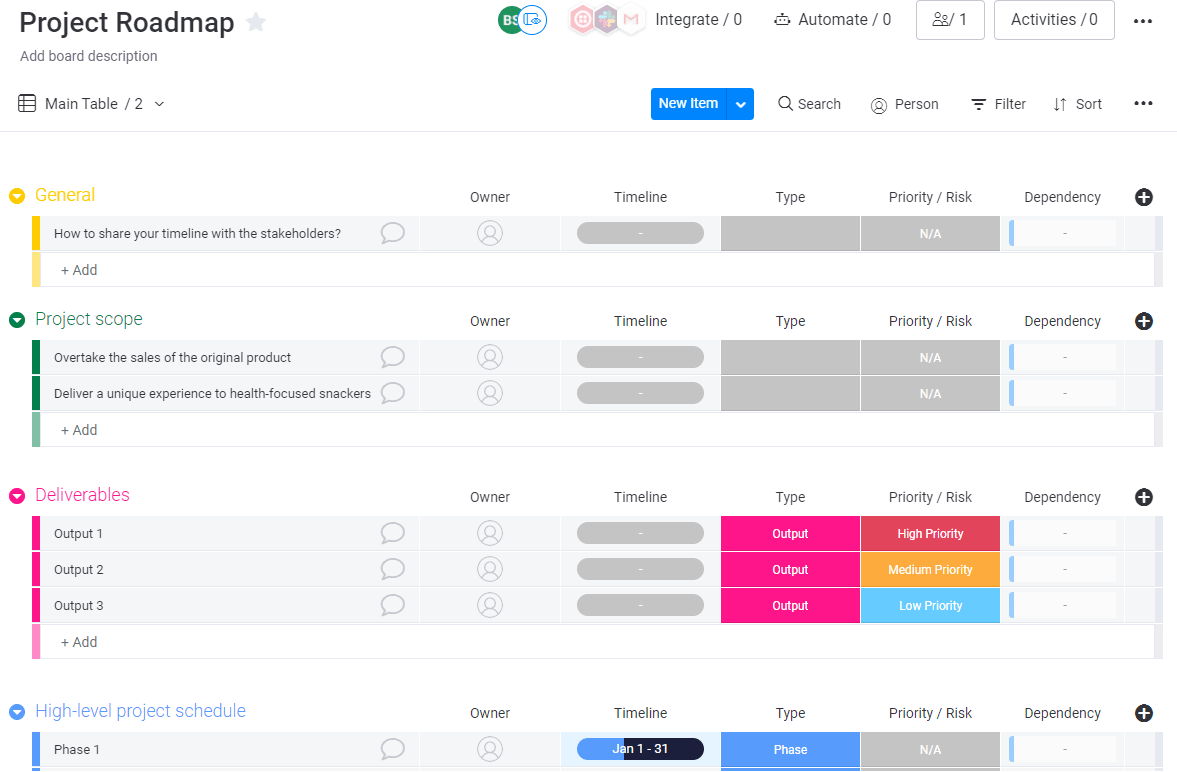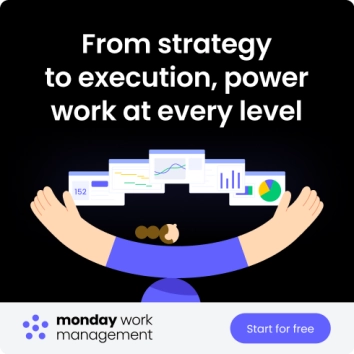A clear project roadmap gives everyone the same big-picture view of where a project is going and why it matters. It helps teams stay aligned, gives leaders confidence in the plan, and makes it easier to communicate progress without getting lost in task-level details. As work becomes more cross-functional heading into 2026, having a roadmap that’s visual, flexible, and easy to update isn’t just helpful — it’s essential.
This article breaks down what a project roadmap is, how it differs from a project plan, the components that make it effective, and the steps to create one that supports real-world delivery. You’ll also see how teams can bring their roadmap to life with monday work management, plus a few roadmap styles and presentation tips to help you communicate clearly with stakeholders.
Key takeaways
-
Understand the purpose: a project roadmap provides a high-level view of goals, milestones, and timelines so teams and stakeholders stay aligned.
-
Know what to include: clear objectives, major deliverables, resources, dependencies, and a realistic timeline form the core of any strong roadmap.
-
Build with clarity: simple visuals make it easier to communicate direction, especially when presenting to executives.
-
Keep it adaptable: a roadmap should evolve as priorities shift or new information surfaces.
-
Use monday work management: the platform helps teams build visual, connected roadmaps that update automatically as work progresses.

What is a project roadmap?
A project roadmap is a high-level visual overview that shows your project’s goals, major milestones, and expected timeline on a single page. It distills the essentials of your project scope so teams and stakeholders can quickly understand what’s happening, when key moments will occur, and how the work fits together.
Rather than outlining every task, a roadmap highlights the big commitments — the outcomes you’re working toward, the major phases of work, and the sequence of events needed to reach the finish line. It helps teams stay focused on shared priorities, gives decision-makers a clear line of sight into progress, and creates a central reference point that keeps everyone aligned as the project moves forward.
Why a project roadmap matters for project success
good project roadmap does more than outline dates on a timeline — it gives your team and stakeholders a shared starting point. With one view of the project’s direction, everyone can understand what matters most and how major phases connect, without digging through detailed plans.
It’s essential because it helps you:
-
Align around shared goals: the big-picture view makes it clear what the project is trying to achieve and how success will be measured.
-
Clarify project scope: focusing on high-level phases and deliverables helps teams quickly spot work that falls outside the original intent.
-
Strengthen communication: when everyone references the same roadmap, conversations stay consistent and cross-team collaboration becomes easier.
-
Support better decisions: visibility into timing, dependencies, and constraints helps leaders adjust plans before issues escalate.
-
Set realistic expectations: stakeholders can see what’s coming and when, making progress updates and approvals more predictable.
Project roadmap vs project plan: differences explained
A project roadmap and a project plan serve different purposes, but teams often mix them up. The roadmap gives you the big picture; the plan explains how the work will actually get done. Both are important, and understanding the distinction helps you set the right expectations from the start.
A clearer way to think about the difference:
-
A project roadmap shows the strategy:
It highlights goals, major milestones, phases of work, and the timing that ties everything together. It’s built for alignment and communication — especially with stakeholders who don’t need task-level detail. -
A project plan shows the execution:
It translates the roadmap into the day-to-day actions needed to deliver the work. This includes tasks, owners, dependencies, estimates, risks, and workflows that guide the team through each phase. -
The roadmap answers the “why, what, and when”, the plan answers the “how”:
Keeping these roles separate helps prevent unnecessary complexity in your roadmap while ensuring the plan has the detail your team needs to deliver.
Used together, they help you tell a consistent story: the roadmap sets the direction, and the project plan explains how your team will bring that direction to life
The 7 key components of an effective project roadmap
A strong project roadmap highlights the essentials of the work ahead without overwhelming teams with detail. These components help stakeholders understand direction, spot risks early, and stay aligned throughout the project’s lifecycle.
-
Clear goals: this is where you define what the project needs to achieve and why it matters. Your project objectives give everyone a shared definition of success and guide decisions as work progresses.
-
Major checkpoints: these are the key moments that show the project is moving in the right direction. Milestones can include approvals, completed phases, or any event that signals meaningful progress.
-
Defined outputs: every roadmap should outline the core deliverables the project will produce. This includes both tangible items and critical internal outputs like finalized designs or documentation.
-
Resource overview: teams need to understand which roles, skills, or budget categories are required to deliver the work. A high-level view of resources helps surface capacity gaps early.
-
High-level scheduling: a simplified project timeline shows when major phases start and finish. Many teams visualize this with a Gantt chart to make overlaps, sequencing, and critical periods easy to spot.
-
Linked work: dependencies show which activities rely on others to move forward. Mapping these connections reduces surprises and helps teams coordinate more effectively.
-
Ownership clarity: listing the people responsible for major work areas or decisions ensures that stakeholders always know where to go for updates or approvals.

How to create a project roadmap: simple steps to follow
Building a project roadmap works best when you move from big-picture thinking to structured detail. These steps help you shape a clear, realistic overview that’s easy to share, easy to update, and grounded in the work your team needs to deliver.
Step 1: define the purpose
Begin by clarifying why the project exists and what outcome it’s intended to create. Capture the problem you’re solving, the benefits you expect to deliver, and the organizational priorities the project supports. This foundation keeps the roadmap focused and ensures every milestone or phase you map later ties back to a clear purpose.
Step 2: gather essential information
Collect the high-level details that will shape your roadmap. This includes strategic goals, early risks, expected workstreams, initial requirements, and the major decision points that will influence progress. At this stage, you’re not building a task list — you’re gathering the context that informs bigger decisions about direction, timing, and scope.
Step 3: outline the structure
Start mapping the major phases of work and place them roughly in sequence. Look for natural groupings of activities, critical handoffs between teams, and major checkpoints that indicate progress. This structure becomes the backbone of your roadmap and sets up the timeline you’ll refine later.
Step 4: choose a clear format
Select a visual format that helps stakeholders understand the plan quickly. Many teams use a project roadmap template to get started, then customize it with views like horizontal timelines, phased layouts, or Gantt-style visuals. The layout should make relationships, pacing, and key moments instantly clear — even to someone seeing it for the first time.
Step 5: collaborate with stakeholders
Review your draft with the people who will guide, approve, or deliver the project. Their input helps confirm priorities, highlight missing steps, and surface dependencies that aren’t obvious on paper. This collaboration not only improves accuracy but also builds early buy-in, which is essential for long-term alignment.
Step 6: keep it up to date
A roadmap has the most value when it reflects the current reality of the project. Revisit it regularly to adjust phases, refine dates, or re-sequence work as priorities evolve. This becomes especially important if your team follows an Agile approach, where new information and shifting requirements are expected. Keeping the roadmap current ensures stakeholders always understand the direction — not just the original plan.

How to present your project roadmap to executives
Presenting your roadmap to executives is your chance to tell a compelling story and secure their confidence. Here’s how to make it count:
- Start with the ‘why’: immediately connect the project to the company’s strategic goals. Explain the problem it solves or the opportunity it captures.
- Keep it high-level: executives care about outcomes, not tasks. Focus on major milestones, key deliverables, and the expected business impact (like ROI or market share).
- Be visual: use a clean, easy-to-read format like a Gantt chart or timeline view from monday work management. Visuals make complex information digestible at a glance.
- Address the risks: briefly mention potential risks and your mitigation plan. This shows you’ve done your homework and builds trust with your stakeholders.
- Be prepared for questions: have the details ready, but don’t lead with them. Use your project plan as a backup for any deep-dive questions.

Power your project roadmap with monday work management
A project roadmap is most effective when it stays connected to the work that brings it to life. monday work management gives teams a flexible environment where planning and execution sit side by side, making it easier to keep roadmaps accurate, collaborative, and ready for change.
The platform supports every stage of roadmap creation and maintenance:
-
Visual planning tools: Timeline View, Gantt chart visuals, and Calendar View let you map phases, milestones, and dependencies in a format that’s easy for anyone to understand at a glance.
-
Real-time updates: when teams update items, statuses, or owners, your roadmap reflects those changes automatically. You never have to chase down the latest version.
-
Automations that reduce manual work: simple rules keep dates aligned, notify stakeholders of important shifts, and help maintain consistency across multiple workstreams.
-
Cross-team collaboration: comments, files, and shared boards bring discussions and decisions into one space so stakeholders can weigh in without long email threads or scattered documents.
-
Dashboards for leadership visibility: customizable dashboards turn roadmap-level data into insights on progress, risks, and resource allocation, giving leaders a clear picture without needing a full deep dive.
-
Connected documentation: Docs lets you store context — like project objectives, requirements, or meeting notes — directly alongside your roadmap so information is never siloed.
Because no two projects are alike, monday work management also gives you the freedom to shape the roadmap format that fits your needs:
-
Agile project roadmap: great for sprint-based teams who plan around themes and epics instead of rigid dates.
-
Marketing campaign roadmap: supports channel planning, asset timelines, and cross-functional collaboration.
-
Strategic goals roadmap: connects high-level objectives to the initiatives driving them forward.
-
Portfolio roadmap: consolidates multiple project roadmaps into a single, high-level view using a Portfolio Dashboard or the Project Portfolio Management Template.
By combining flexible planning, visual tools, and connected execution, monday work management turns your roadmap into a living source of truth — one that evolves with your project and keeps every team member aligned on what’s happening next.
Frequently asked questions
What level of detail should a project roadmap include?
A roadmap should stay high-level and focus on strategic elements like goals, major phases, and milestones. Task-level details belong in your project plan, not the roadmap. Keeping it simple ensures stakeholders can understand the direction quickly.
How often should a project roadmap be reviewed?
Most teams review their roadmap monthly or at major project checkpoints. If your team works in shorter cycles or follows an Agile approach, reviewing it at the start or end of each sprint helps keep it accurate.
Who is responsible for maintaining a project roadmap?
Project managers typically own the roadmap, but it’s shaped through input from team leads, key stakeholders, and decision-makers. The goal is shared accountability: one owner maintains it, but many contribute to it.
Can a project roadmap change after the project begins?
Yes — and it should. Roadmaps are living documents that evolve as priorities shift, risks emerge, or timelines change. Adjusting the roadmap keeps stakeholders aligned and ensures decisions reflect the most current information.

